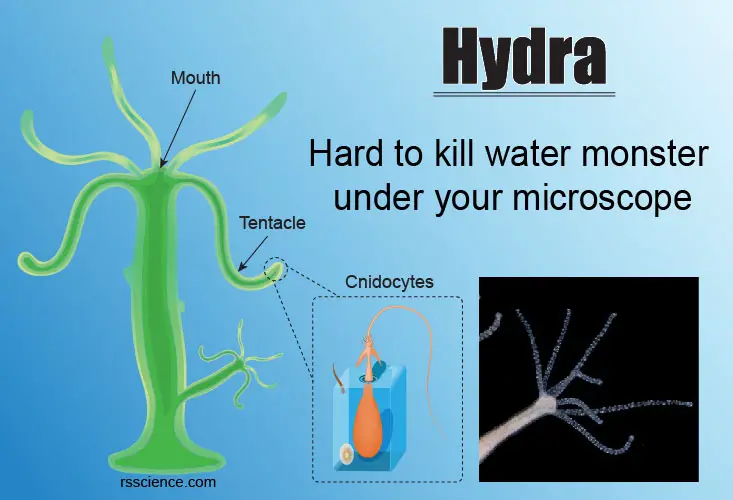This article covers
What is Hydra? A quick overview
Hydra is a genus of tiny fresh-water organisms that are classified under the phylum of Cnidaria. Hydra has a cylindrical, radially symmetric body from 2 to 20 mm in length. It is visible to the naked eyes when fully extended.
Typically, hydras remain attached to some underwater objects, waving their tentacles slowly with the current. This is why the hydra is often mistaken for a plant or alga. However, it is a bona fide animal!
[In this video] A summary video about hydra.
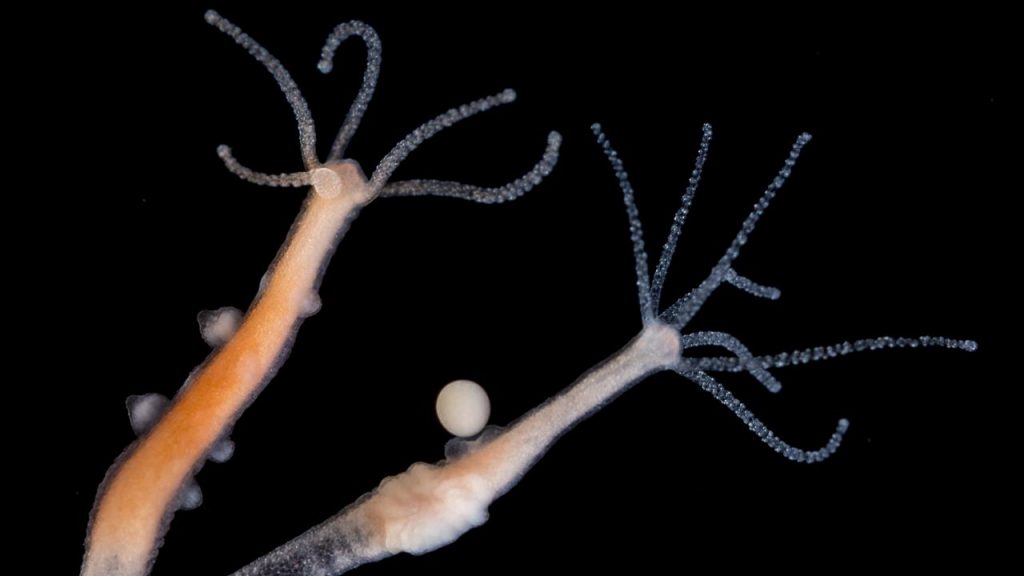
[In this image] Two brown hydras.
Photo credit: Ucdavis
Hydra is characterized by its tentacles around the mouth opening. These tentacles can greatly extend to catch the prey or use for locomotion. Each tentacle is clothed with many stinging cells. Upon contact with prey, the contents of the stinging cells are explosively discharged, firing stings that can paralyze small animals.
Biologists are especially interested in hydra because of their remarkable regenerative ability – they do not appear to die of old age, or to age at all.
In this article, you will learn about this fantastic creature in detail: by definition, classification, and cellular structure. I will show you several interesting behaviors when a hydra feeds or move. We will also see what happens to a sick hydra. Finally, you will also learn where and how to collect a hydra for your microscopic project. Let’s dive in.
Classification of Hydra – the Phylum Cnidaria
Hydras are classified under the phylum Cnidaria and the class Hydrozoa. Examples of Cnidarians include jellyfish, sea anemones, corals, and hydras. They all share a feature: “using stinging cells to protect themselves or hunt for food”. They are predominantly marine species, but a smaller number of species (including hydras) are found in rivers and freshwater lakes.
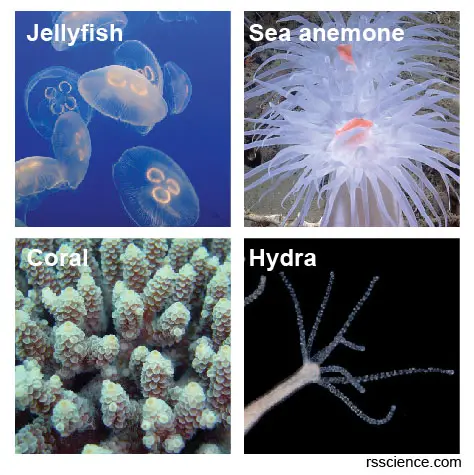
[In this image] The examples of Cnidarians.
Cnidarians are incredibly diverse. Examples of Cnidarians include jellyfishes, sea anemones, corals, and hydras.
Images credit: jellyfish, sea anemone, coral from NOAA, hydra from Stefan Siebert/Juliano Lab.
Scientific classification
Kingdom: Animalia
Phylum: Cnidaria
Class: Hydrozoa
Order: Anthoathecata
Family: Hydridae
Genus: Hydra
(Reference: wiki)
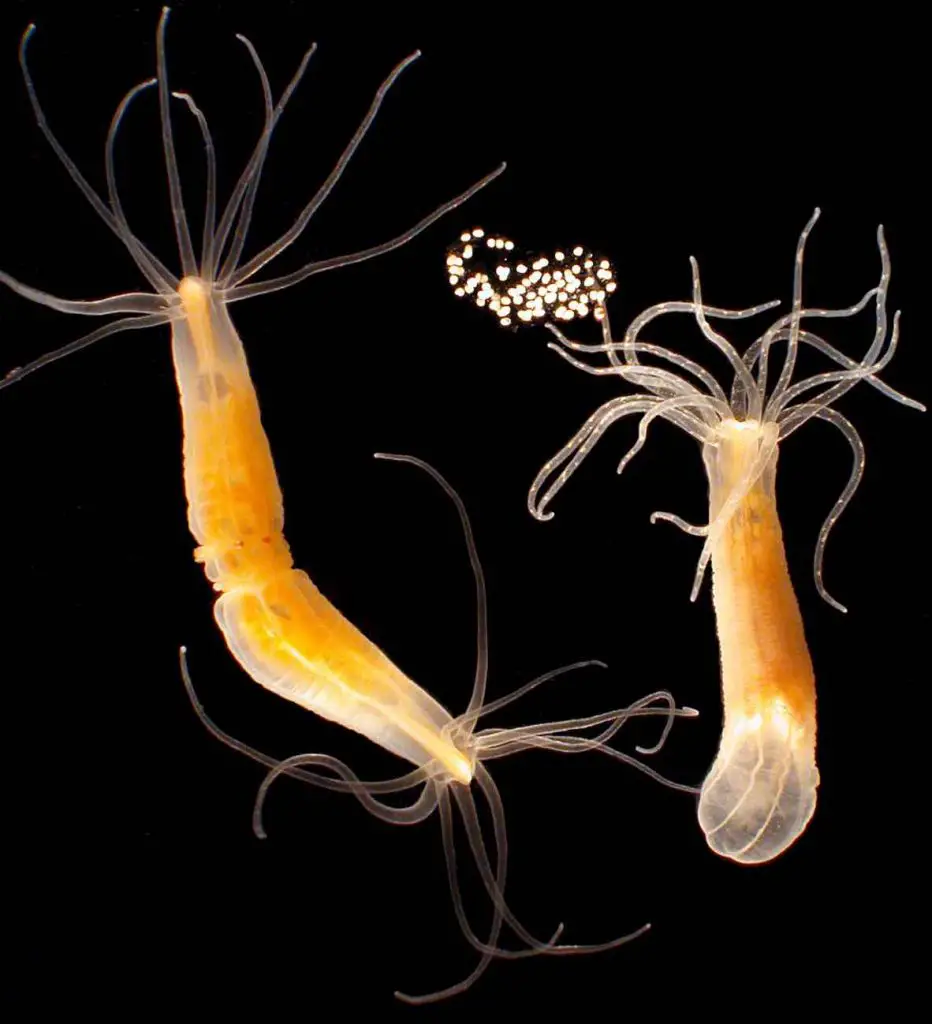
[In this image] Hydras.
Photo credit: Dr. Sebastian Fraune
Where does a Hydra Live?
Hydras live in all kinds of freshwater habitats, including ponds, ditches, and slow-flowing rivers and streams. They are native to temperate and tropical regions. Hydra usually anchors itself to a substrate like a water plant by its foot.
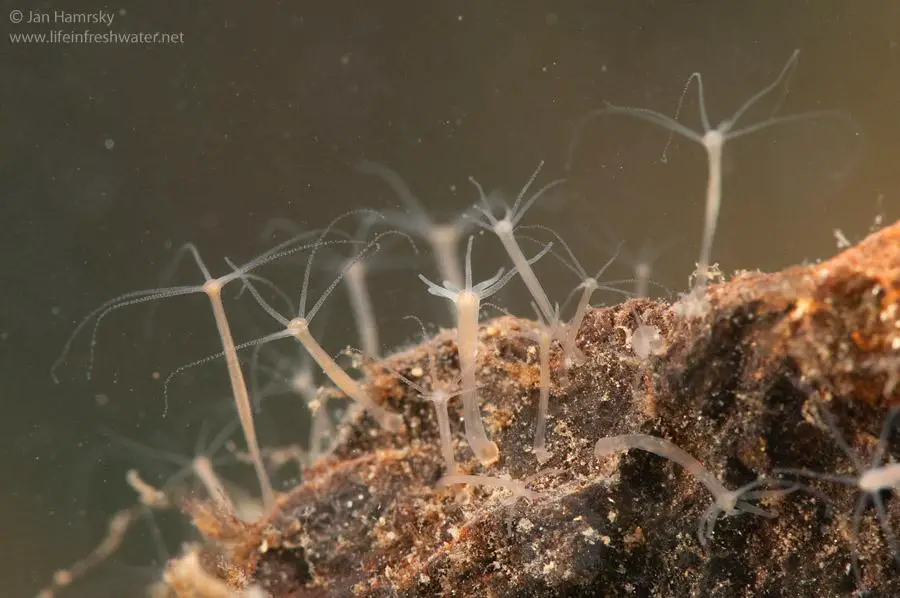
[In this image] A group of brown hydras (Hydra oligactis) on a rock.
Photo credit: Jan Hamrsky
Is a Hydra Sensitive to Pollution?
Yes, hydra has a low tolerance for pollution. Since hydra cannot be found in contaminated water, they can be used as a biological indicator to rank toxicants on the level of a potential hazard.
The Body Structure of Hydra
A single hydra is composed of 50,000 to 100,000 cells.
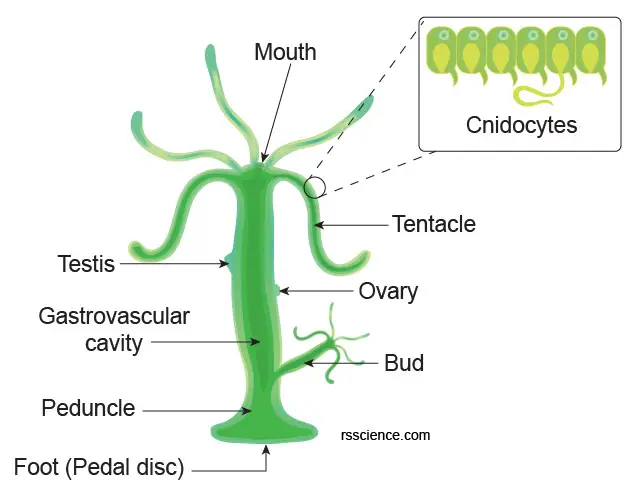
[In this image] A diagram showing the body parts of a hydra.
Size and shape
Hydra has a cylindrical, radially symmetric body from 2 to 20 mm in length. It is visible to the naked eyes when fully extended. Their tentacles may extend much longer – some species of green hydra may measure about 5 cm to 20 cm when extended. The body of a hydra may retract (while sensing a danger), making the organism appear shorter and rounded.
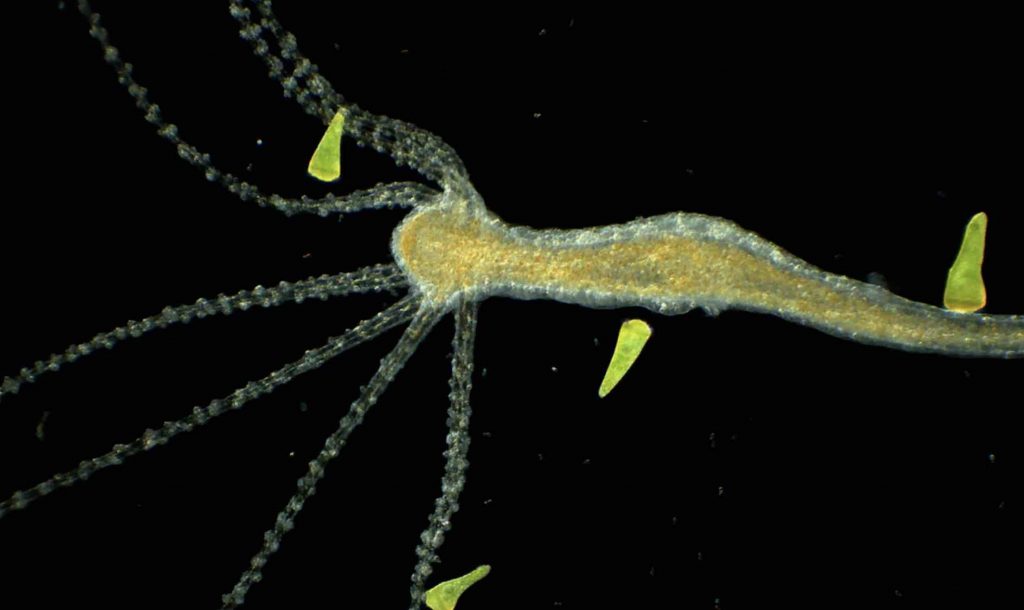
[In this image] The size comparison between hydra and green stentors.
Stentors are almost the largest single-celled ciliates and can grow up to 4 mm. These stentors in the picture are around 300 µm. You can see the hydra is much bigger than stentors.
Color
A small hydra may look transparent in its tentacles and yellowish in its tube-like body. Hydra oligactis is brown; therefore, also known as the brown hydra Hydra viridissima is commonly called green hydra because of its distinctive color due to the symbiotic green algae Chlorella that live within its body.
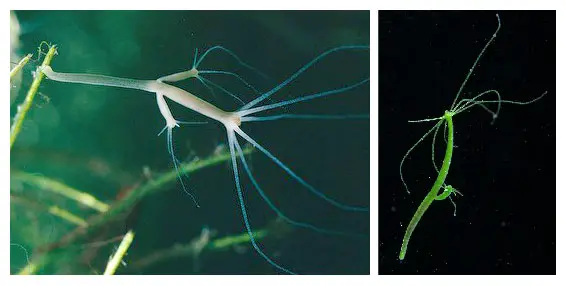
[In this image] Left: Hydra oligactis. Right: Hydra viridissima.
Photo credit: Hydra oligactis, Hydra viridissima
Body
Hydra has a tubular body with radial symmetry. The radial symmetry is also a shared feature of the phylum Cnidaria. The center of the hydra’s body tube is a hollow body cavity (gastrovascular cavity).
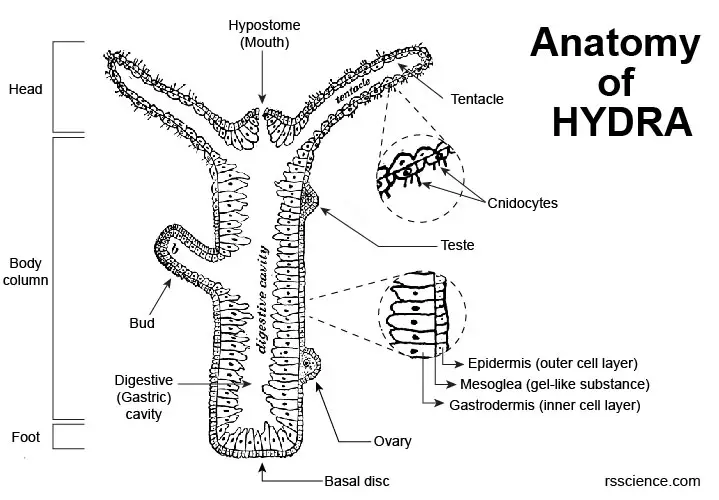
[In this image] Longitudinal section showing the anatomy of Hydra.
You can see the body wall of a Hydra consisting of two layers of cells. Modified from Alvin Davison, Practical Zoology (New York: American Book Company, 1906).
The cells making up a hydra’s body are relatively simple. Hydra has two main body layers. The outer layer is the epidermis (like our skin) which can secret a protective layer (hydramacin) against bacterial infection. Respiration and excretion occur by diffusion through the surface of the epidermis.
The inner layer is called the gastrodermis, which lines the stomach. Between the two layers is a gel-like substance called mesoglea.

[In this image] Stained hydra’s body column section showing two layers of cells – epidermis and gastrodermis, with mesoglea in-between.
Modified from Vogg MC., et.al, Development, 2019
Foot
The bottom end of a hydra is secured on the surface by a simple adhesive foot called the basal disc. Gland cells in the basal disc secrete a sticky fluid that accounts for its adhesive properties.
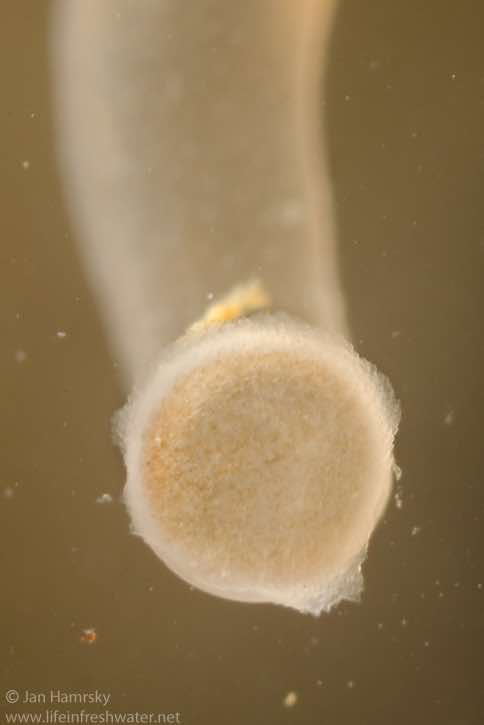
[In this image] Viewing the bottom of a basal disc when a hydra attaching on the glass wall.
Photo credit: Jan Hamrsky
Mouth
At the free end of the body is a mouth opening (hypostome) surrounded by tentacles. The mouth is connected to the body cavity. The prey captured by the tentacles will then be engulfed within the body cavity for digestion. Since hydra has only one opening, the waste after digestion will be discharged through the same mouth opening.
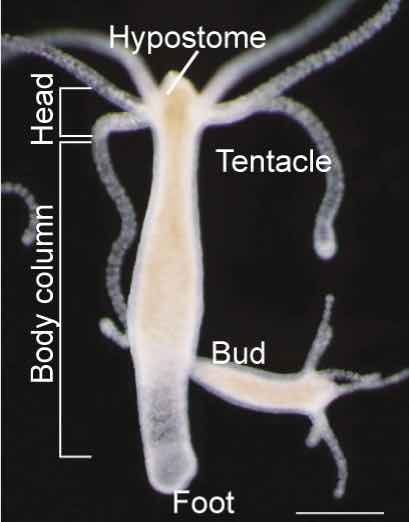
[In this image] Labeled diagram of a hydra’s major body parts.
Modified from Vogg MC., et.al, Development, 2019
Tentacles and Cnidocytes
Tentacles (from 6 to 10 in number) radiate outward from the rim of the mouth. These tentacles can be greatly extended at the time of feeding or locomotion.
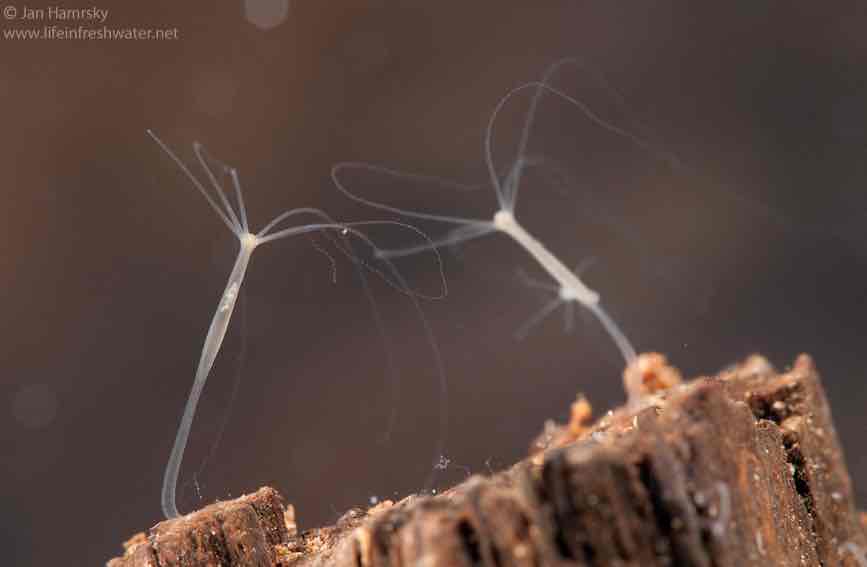
[In this image] Two hydras with fully extended tentacles.
Photo credit: Jan Hamrsky
Each tentacle is covered with highly specialized stinging cells called cnidocytes. Cnidocytes contain specialized structures called nematocysts, which look like miniature light bulbs with a coiled thread inside. Near the outer edge of the cnidocyte is a short hair, called a cnidocil. The cnidocil functions like a trigger to control the firing of a nematocyst.
[In this video] Green hydra catches daphnia by using its tentacles.
Upon contact with prey, the contents of the nematocyst are explosively discharged, firing a dart-like thread containing neurotoxins into whatever triggered the release. These toxins can paralyze the prey.
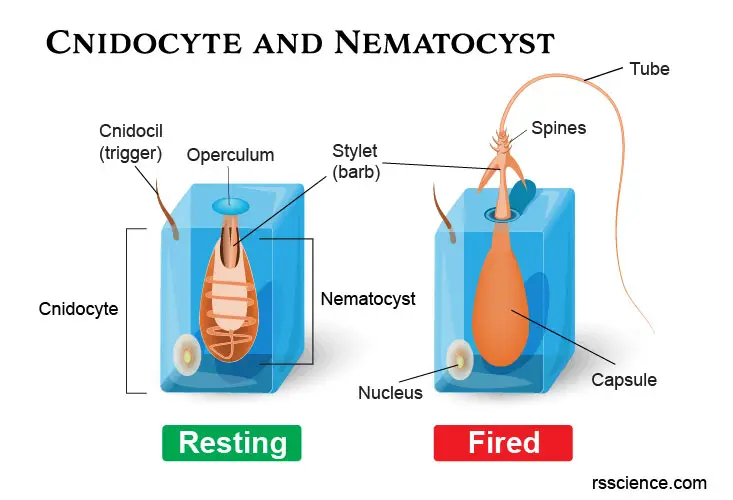
[In this image] A cnidocyte is an explosive cell used for prey capture and defense from predators that defines the phylum Cnidaria.
A cnidocyte fires a structure that contains the toxin from a characteristic subcellular organelle called a nematocyst. Left: a cnidocyte at the resting stage. Right: a fired cnidocyte.
Nervous System
Hydra does not have a recognizable brain or true muscles, but hydra has a primitive nervous system called the nerve net. Nerve nets connect sensory photoreceptors (light-sensitive) and touch-sensitive nerve cells located in the body wall and tentacles. This simple nervous system helps hydra quickly respond to all kinds of stimuli.
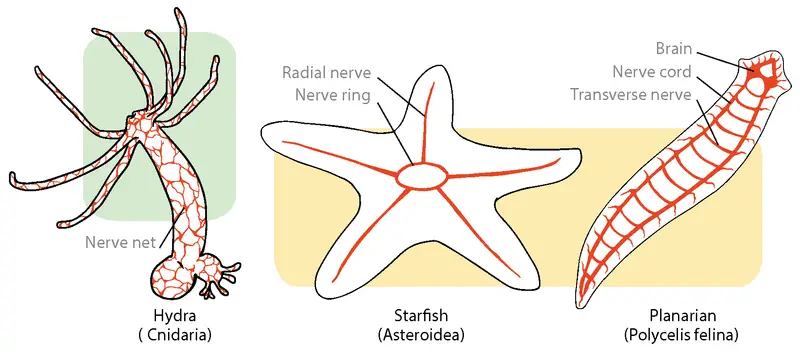
[In this image] The nervous system of invertebrates – Hydra, Sea star, and Planarian. You can see the hydra has a network-like nerve system.
Photo credit: ck12
Recently, scientists found that hydras can rest in a sleep-like state even it has no brain!
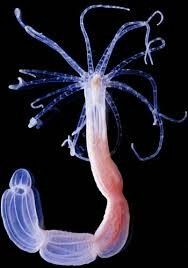
[In this image] A beautiful hydra has a primitive nervous system.
Photo credit: U Heidelberg
How does a Hydra Hunt for Food?
Hydras mainly feed on aquatic invertebrates such as Daphnia. While feeding, Hydras extend their body to maximum length and then slowly extend their tentacles. Once fully extended (can be four to five times the length of the body), the tentacles are slowly maneuvered around, waiting for contact with suitable prey.
Upon contact with prey, hundreds of nematocysts can fire their stings and neurotoxins at the same time. This can paralyze the prey. Within minutes, the tentacles can surround the prey and move the prey into the opened mouth aperture. The prey will then be engulfed within the body cavity for digestion.
[In this image] The entire process of Hydra feeding.
Hydra can stretch its body wall considerably in order to digest prey more than twice its size. Since hydra has no anal pore, the indigestible remains of the prey will be discharged through the mouth aperture via contractions.
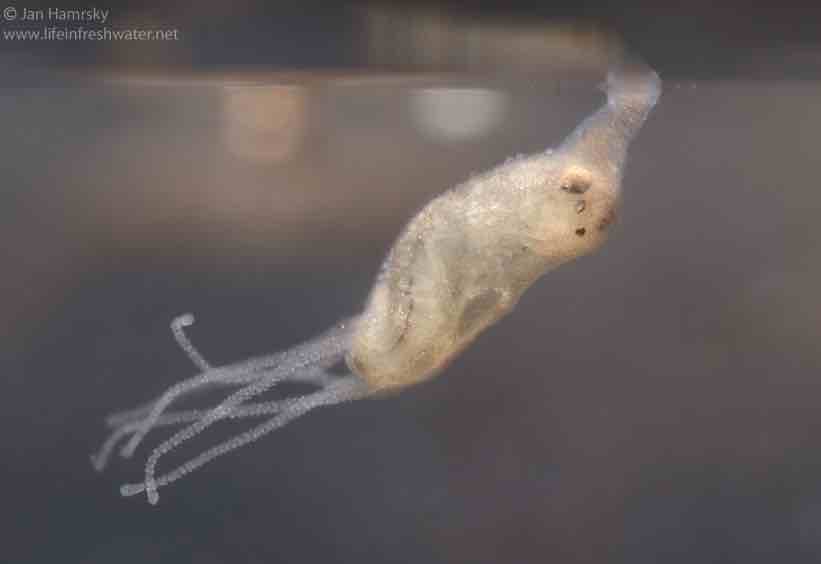
[In this image] A Hydra with a prey (maybe a mayfly nymph) enclosed within the body cavity during digestion.
Photo credit: Jan Hamrsky
[In this video] New research found that before a hydra can eat its prey, it must rip itself apart to form a mouth. The mouth disappears after it eats, meaning a hydra regrow a new mouth for each bite. Is that amazing?
Hydra Symbiosis and Photosynthesis
Some Hydra species (like Hydra viridissima) can form a symbiotic relationship with green algae (Chlorella) living within its body. Hydra provides a safe place to live, and green algae synthesize food (by photosynthesis) in return.
This symbiosis gives a significant advantage to hydras when environmental conditions change (food is scarce). In the absence of prey, a green hydra may still be able to survive for about 3 months using nutrients produced through photosynthesis. This allows the hydra to tolerate starvation.
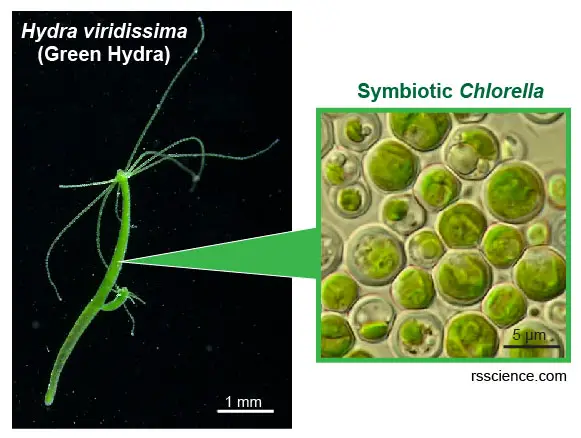
[In this image] Hydra-Chlorella symbiosis.
Green hydra Hydra viridissima and its symbiotic algae Chlorella sp.
Modified from Marinespecies
Can a Hydra Move?
Yes. Typically, a hydra remains attached by the basal disc to some suitable object in the water. However, occasionally hydra can move quite readily, especially when hunting.
[In this video] Hydra movement.
They have two major methods for moving – “looping” and “somersaulting”.
Looping
Looping is the most common type of walking similar to the movement of a caterpillar. They do this by bending over and attaching themselves to the surface with their mouth and tentacles and then relocating their foot.
Somersaulting
In somersaulting (meaning rolling forward), the hydra extends its body and bends to one side to place its tentacles on the surface. The basal disc is free from its attachment, and the animal stands on its tentacles. The body is then extended and bent to place the basal disc on the surface, the tentacles loosen their hold, and the animal regains an upright position. These movements are repeated, and the hydra moves from place to place.
Hydra can occasionally move in other ways (see image below). Interestingly, a hydra can generate a gas bubble from its foot and then anchor itself on the bubble for floating, like riding a hot air balloon!
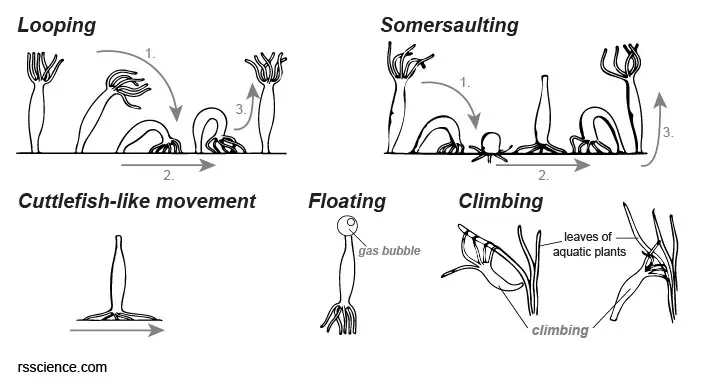
[In this image] A hydra can move in several different ways:
(1) Looping and
(2) Somersaulting is two major methods of movement by bending and relocating either the foot or tentacles.
(3) Hydra can also move over the surface by pulling its tentacles along like walking (Cuttlefish-like movement).
(4) Sometimes, hydra can produce a gas bubble from the basal disc which helps the animal to float on the surface of the water and is passively carried from one place to another by the water current.
(5) In a bush of aquatic plants, a hydra can climb by attaching its tentacles to some distant object, and then by releasing the basal disc and contracting the tentacles, the body is drawn up to a new position.
Reproduction of Hydra
Hydra can reproduce both asexually and sexually. The choice of reproduction depends on the conditions where they live.
Asexual Reproduction in Hydra
Asexual reproduction occurs under favorable environmental conditions to allow a rapid expansion of the hydra population.
Asexual reproduction only requires one parent. Hydra reproduces asexually through “budding”. During budding, a small bud develops near the basal part of the parent hydra through repeated mitotic cell division. These new cells grow into a mini version of hydra with smaller body, mouth, and tentacles.
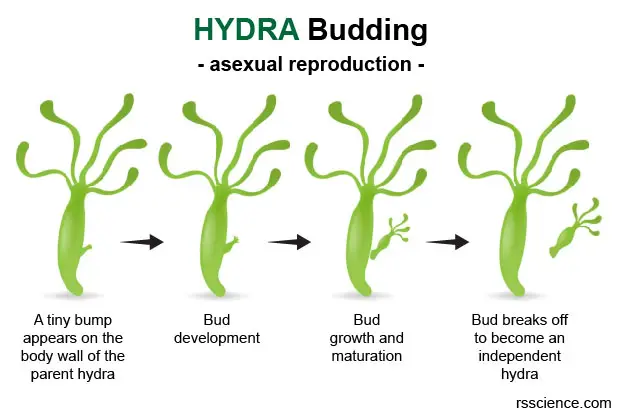
[In this image] The steps of hydra’s asexual reproduction by budding.
Once the bud is fully developed, it ultimately detaches from the parent and becomes an independent organism. Given that the offspring is produced through mitosis division, it is genetically identical to its parent. This budding process may take about 3 days from start to end.

[In this image] A hydra with two buds on its body wall.
Photo credit: Jan Hamrsky
Sexual Reproduction in Hydra
On the contrary, sexual reproduction occurs when environmental conditions become unfavorable. Such conditions could be the low temperature and the lack of sufficient food sources. To increase the chance of survival, hydras will prepare for sexual reproduction.
To initiate the process of sexual reproduction, reproductive stem cells on the body wall will become ovaries and testes. Hydra could have three sexes: female (has ovaries), male (has testes), and hermaphrodite (has both ovaries and testes). Hermaphrodite is common in hydra.
[In this video] A green hydra has testes (white gonads on its body wall), a bud (baby), and an Ostracod (crustacean) in its gut.
Ovaries develop near the bottom of the hydra while testes form near the top. Each ovary hosts one egg cell. Sperm enter the ovaries of another hydra by swimming. A fertilized egg may not develop right away in harsh conditions, and instead, the egg produces a protective shell and enters a dormancy as “arrested development”. Once good conditions come again, the egg resume developing into a new hydra (there is no larval stage).
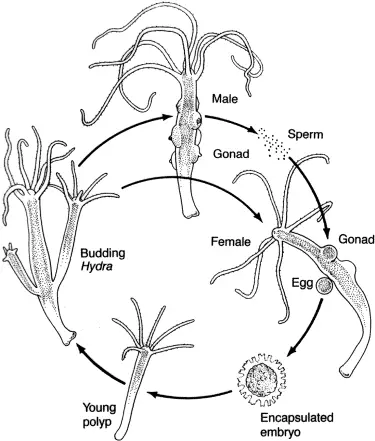
[In this image] The life cycle of hydra including both asexual and sexual reproduction.
Photo credit: sarahinbiology
How did the Name “Hydra” Come from?
The name “Hydra” came from a snake-like water monster in Greek and Roman mythology, called The Lernaean Hydra or Hydra of Lerna. In the story of Hercules, this hero was known for his many adventures, especially the “Twelve Labors”. The second Labor is to slay the nine-headed Lernaean Hydra. Today, we still can see the Battle between Hercules and the Hydra on many artworks dated from ancient Greece to the Renaissance. Also, in the Disney cartoon “Hercules”, there is an epic battle between the hero and the many-headed Hydra.
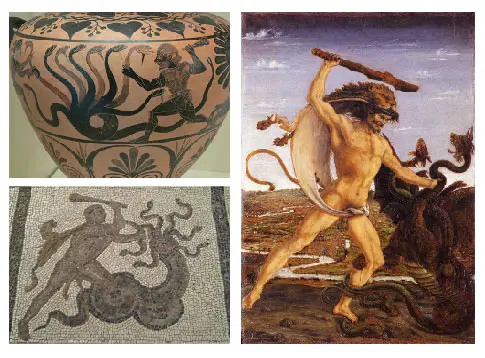
[In this image] Hydra in the art.
Left-top: Roman black-figure pottery painting of Hydra (c. 346 BC; image by Wolfgang Sauber). Left-bottom: The Twelve Labours Roman mosaic from Llíria (Valencia, Spain; 26 AD; image by Luis García). Right: Pollaiuolo’s Hercules and the Hydra (c. 1475). Uffizi Gallery, Florence, Italy.
By the way, Hydra is also a fictional terrorist organization appearing in Marvel Comics and movies.
How to Find Hydras for Your Microscopic Project?
Collecting Hydras
Hydra can be found in many unpolluted watery environments. People tend to overlook them because they are so tiny. What you need to do is to acquire a chunk of hydra’s habitat instead of trying to pick hydra one by one.
You can collect sticks, leaves, or submerged vegetation and place the specimens overnight in a petri dish. On the next day, carefully examine the dish under a low-power stereo microscope or magnifying glass; Hydra is usually found.
Hydra is sometimes found in a freshwater fish tank. It is harmless for fish (except freshly hatched fish), but most people may not want to see hydra in their tank. So, you can ask your local aquarium store to see if you can obtain some water plants with hydra for free.
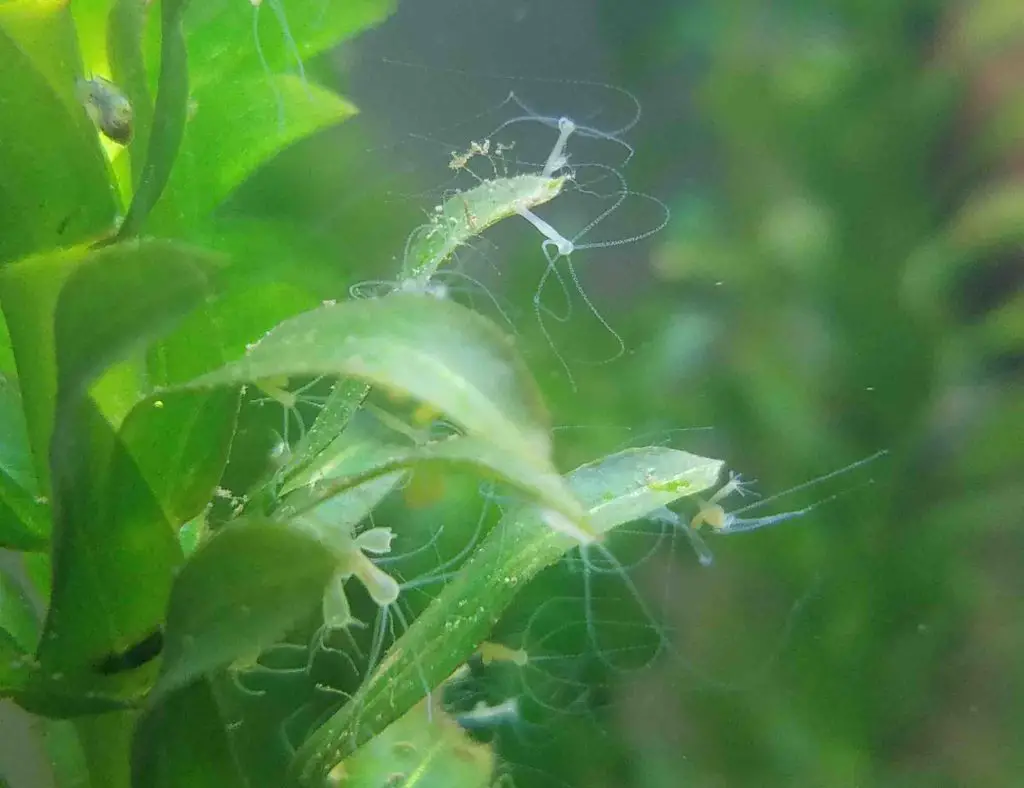
[In this image] Hydras growing on a water plant.
They are considered a pest inside aquariums. You probably can get them for free if you happen to find them.
Culturing Hydras
You can culture a bunch of hydras in a tank or jar for long-term observation. It could be a very good science project in the classroom. You may feed hydras with water flea or freshly hatched brine shrimp. Access to an unpolluted water source (no chlorine, no detergent, no traces of heavy metals) is the most critical part. You can use good spring water, bottled water, or glass-distilled water. A room temperature between 17ºC – 23ºC is ideal for hydras.
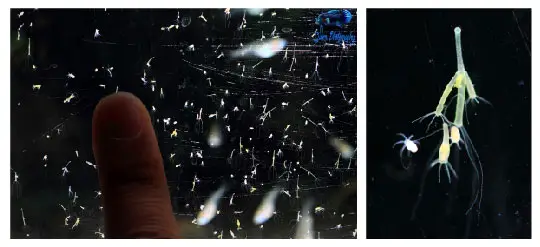
[In this image] Many hydras grow on the glass wall of a fish tank.
Photo credit: Amazonas
If you want to know more about culturing and studying hydra, the article by Patricia Bossert and Brigitte Galliot has great detailed information:
“How to use Hydra as a model system to teach biology in the classroom” by Patricia Bossert and Brigitte Galliot“
How Can I Tell if a Hydra is Healthy or Sick?
In Patricia Bossert and Brigitte Galliot’s article, they provide us a pretty comprehensive guide about how to learn the principles of biology using these tiny creatures. It is particularly interesting that in the article, Patricia and Brigitte mentioned the “Hydra Health Index” to answer a fundamental question “Are the hydra happy?”
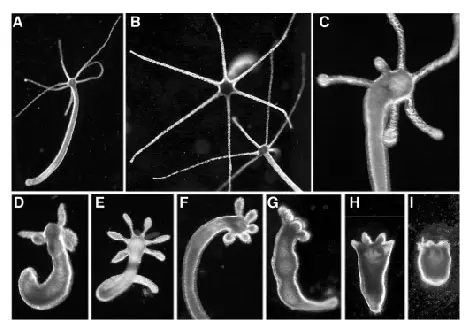
[In this image] Five health states can be used for assessing hydra health: healthy hydra has thin and extended tentacles (A, B).
The early signs of “depression” are recognized by the rounded knobs on the tips of the tentacles (C-E).
Progressively, the tentacles become extremely short, providing a “flower” phenotype corresponding to the loss of the feeding behavior (E-F). Subsequently, the animal size is drastically reduced (G, H).
It precedes the complete loss of tentacles and dissociation (I).
Photo credit: Patricia Bossert and Brigitte Galliot
Is Hydra Harmful to Humans?
The answer is No. The hydra’s cnidocytes are not harmful to humans, as the stinger cannot penetrate sufficiently into human skin to inflict any harm. However, some species in the phylum Cnidaria – especially the jellyfish, can deliver extremely painful, and in a few cases, even fatal stings to humans.
How is Hydra’s Regenerative Capability?
Hydra has a tremendous regeneration potential, capable of regenerating a complete organism from small tissue fragments or even from dissociated cells. Hydra regenerates through morphallaxis, which is the repatterning of existing cells and tissues. The steps of regrowing its whole body from a small piece of tissue can be accomplished in just a few days.
Biologists are particularly excited by this ability since many of the genes involved in the healing process developed early in the process of evolution, meaning that they are shared among many animals, including humans. If hydra’s regeneration ability can be fully understood, it could potentially be harnessed to heal trauma or degenerative diseases in human patients.
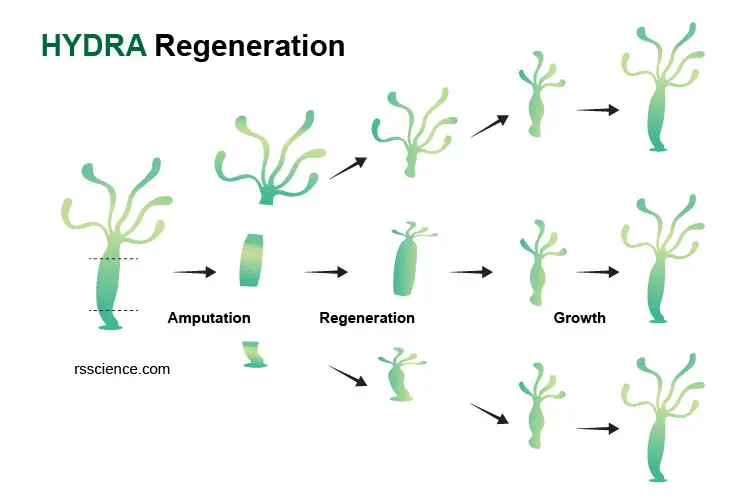
[In this image] Hydra regeneration.
When a hydra is cut in half, each half will regenerate and form into a small hydra; the “head” will regenerate a “foot” and the “foot” will regenerate a “head”. If the hydra is sliced into many segments, then the middle slices will form both a “head” and a “foot”.
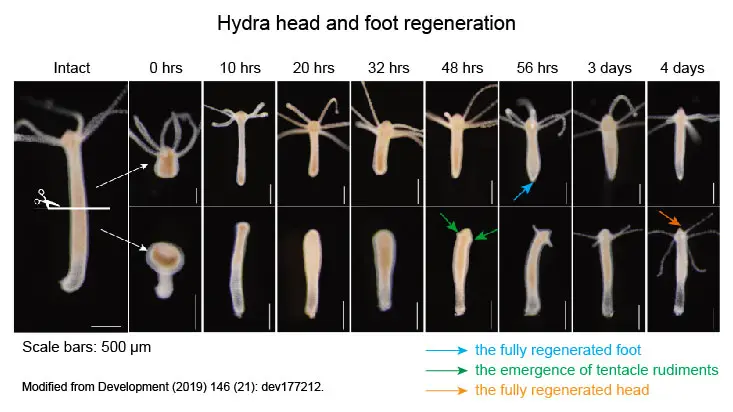
[In this image] A series of time-lapse pictures showing the regeneration of hydra in 4 days.
Modified from Vogg MC., et.al, Development, 2019
Another creature that has a remarkable regeneration ability is the planarian.
Summary
1. Hydra is a freshwater polyp of the phylum Cnidaria. Cnidarians also include jellyfish, sea anemones, and corals.
2. Hydra grows by anchoring itself to an underwater substance. It is very sensitive to the pollution of water.
3. Hydra has several tentacles, which can catch the prey by paralyzing it with stinging cells (cnidocytes).
4. Hydra can reproduce both asexually and sexually. Asexual reproduction is done by budding a small new hydra from the body wall of the parental hydra.
5. Hydra has a remarkable ability to regenerate. A fragment can regrow into a new hydra in a few days.
References
“How to use Hydra as a model system to teach biology in the classroom” by Patricia Bossert and Brigitte Galliot
“A sleep-like state in Hydra unravels conserved sleep mechanisms during the evolutionary development of the central nervous system”
“Model systems for regeneration: Hydra”
“For researchers new to Hydra”

